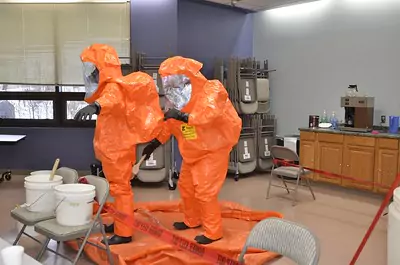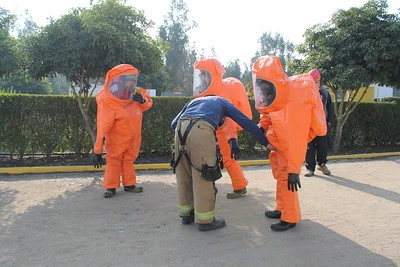Does Online HAZWOPER Training Meet OSHA Requirements?
November 19, 2023 | by onlineoshasafetytraining.com


Online HAZWOPER (Hazardous Waste Operations and Emergency Response) training can meet OSHA requirements, provided it adheres to the specific standards and guidelines set by OSHA. The key aspects that determine if online training is compliant include:
- Training Content Must Be Right and Relevant: The training needs to cover OSHA’s HAZWOPER rules (29 CFR 1910.120). It should talk about things like dangerous substances, safety gear, cleaning up, emergency steps, and safety plans. The information must be up-to-date with the newest OSHA rules.
- Training Should Be Interactive and Interesting: The courses need to be interactive so people really take part. This can include quizzes, practice scenarios, and other activities where the learner has to respond or do something, not just watch.
- Training Time: OSHA says how long the training should be for different jobs. For example, workers at hazardous sites need at least 40 hours of training and three days of field experience with a trained supervisor. The training should match these time requirements.
- Who Teaches Matters: People who make or help with the training should know a lot about dealing with hazardous waste. They should have both real-world experience and knowledge about the topic.
- Need for Hands-On Training: Parts of HAZWOPER training, like using safety gear and responding to emergencies, need hands-on practice. OSHA says this part must be done in person or in a realistic practice setting.
- Keeping Records and Giving Certificates: The training program must keep track of the training, including how long it was and what was covered. After finishing, learners should get a certificate that shows how much and what kind of training they did, following OSHA rules.
- Regular Updates and Extra Training: OSHA requires extra training courses, usually every year, to keep the certification valid. Online programs should provide these extra courses and make sure they’re up to date with the latest rules and ways of doing things.
This form of training can meet OSHA requirements if it thoroughly covers the essential topics, includes interactive and hands-on components, adheres to the specified training durations, and is conducted under the guidance of qualified professionals. Employers are responsible for ensuring the training their workers receive, whether online or in-person, complies with OSHA standards.
Read related article: Can HAZWOPER Certification Be Completed Entirely Online?
Online Training and OSHA Compliance
When considering online training for HAZWOPER and its compliance with OSHA standards, there are several key aspects you should be aware of:
Understanding How Online Training Works for HAZWOPER
- Format and Accessibility: The digital training typically involves a series of modules that you can access remotely. This format allows for flexibility in scheduling, making it a convenient option if you have time constraints.
- Interactivity and Engagement: Look for courses that offer interactive elements like quizzes, videos, and simulations. These features can enhance your learning experience, making the digital format more effective.
- Progress Tracking: Most digital courses provide a way to track your progress. This is important for ensuring you complete all necessary components of the training.
OSHA’s Stance on Online Training for HAZWOPER
- General Acceptance: OSHA recognizes this method training as a viable method for part of the HAZWOPER training. However, it’s important for you to ensure that this course meets specific OSHA requirements.
- Requirement for Hands-On Training: OSHA mandates that certain aspects of the training, particularly those that require hands-on experience, cannot be fully covered online. You will likely need additional in-person training to meet all the guidelines.
Pros and Cons of Online Training in Meeting OSHA Requirements
Pros:
- Flexibility: One of the biggest advantages is flexibility in terms of time and location. You can complete training at your own pace and schedule.
- Cost-Effectiveness: these courses often come at a lower cost compared to in-person training programs.
- Up-to-date Material: Reputable courses are frequently updated to reflect the latest regulations and best practices.
Cons:
- Lack of Practical Experience: The major drawback is the absence of hands-on experience, which is crucial for HAZWOPER training. You’ll need to supplement virtual learning with practical training.
- Varied Quality: The quality of these courses can vary greatly. You need to be diligent in selecting a program that is comprehensive and compliant with OSHA standards.
- Self-Discipline Required: This training requires a high level of self-discipline and motivation. Without the structure of a traditional classroom, some find it challenging to complete the course.
Online training can be easy to access and save money, but it’s important to pick a course that follows OSHA rules and includes the needed practical training. You also need to be self-motivated and active in your learning to really benefit from these courses. The main aim of HAZWOPER training, whether online or in person, is to make sure you’re safe and following the rules when dealing with dangerous waste and in emergency situations.
Read related article: What Happens if the Annual Refresher Training is Missed?
Understanding OSHA’s Stance on Online Training
Let’s read this:
Is computer-based training acceptable for refresher training?
Computer-based training may meet some refresher training requirements, provided that it covers topics relevant to workers’ assigned duties. It must be supplemented by the opportunity to ask questions of a qualified trainer and by an assessment of hands-on performance of work tasks.
Reference Interpretation and Compliance Letters:
Getting to know OSHA’s view on online training, particularly for HAZWOPER, means carefully checking the technical rules and standards from OSHA, and figuring out how online training methods can meet these requirements.
A. OSHA’s General Guidelines for Acceptable Training Methods
- Interactive Communication: OSHA says that the training should let students and teachers talk to each other right away. This means they should be able to communicate quickly, usually getting responses within 24 hours.
- Checking Program Quality: Training courses need a way to check and keep up the quality of the training. This might include looking at how many people finish the course, how well they do in tests after training, and getting feedback.
- Good Technology: The training platform needs the right technology to help with learning. This includes making sure it works most of the time (like being available 99.5% of the time), keeping data safe (following rules like ISO/IEC 27001), and working well with common computer systems.
B. Specific OSHA Requirements for HAZWOPER Training
- Curriculum Standards: The HAZWOPER rules (29 CFR 1910.120) say training must cover certain topics. This includes recognizing hazardous waste, understanding chemical dangers (like exposure limits and life-threatening levels), and knowing what to do in emergencies.
- Training Duration: How long you need to train depends on your job. For example, general workers at hazardous sites need 40 hours of training and three days of working in the field. The number of training hours is set and must be followed.
- Trainer Qualifications: Teachers need to really know their stuff. This is usually shown by how long they’ve worked in the field (like at least 5 years) and their education (like having a degree in occupational health and safety).
C. Analysis of How Online Training Can Align with These Standards
- Incorporating Interactive Elements: Using tools like live online classes, instant question and answer sessions, and interactive practice scenarios. You can tell if these are working well by looking at how much people get involved and how they do on quizzes after the sessions.
- Blended Learning Approaches: Mixing online theory lessons with required hands-on training in the field. This includes keeping track of how long you spend learning online and in person, making sure it’s enough according to OSHA’s rules.
- Adaptive Learning Technologies: Using smart tech like AI to change the training to fit each person’s needs, based on things like how they do on quizzes and how long it takes them to finish sections.
- Continuous Program Evaluation: Regularly checking and updating the training material to keep up with the newest OSHA rules. This might mean reviewing the content every year and using advice from safety experts.
- Certification and Record-Keeping: Online systems should give out certificates that meet OSHA’s standards and keep detailed records of each student’s progress, like how many hours they learn, which parts they finish, and their scores on tests.
Online training can meet OSHA’s rules by making sure the training is interactive, can be measured, and is well-controlled for quality. Using modern technology and sticking to the specific training topics and how long they last are important for following OSHA’s strict rules for safety training at work.
Please take note of this also:
Can you recommend an on-line HAZWOPER (8-, 24-, or 40-hour) course?
OSHA does not recommend, approve, certify, or endorse individual trainers or training programs. It is OSHA’s policy that use of computer-based training by itself would not be sufficient to meet the intent of the standard’s various training requirements. There are two primary considerations for you to explore before deciding whether to take an on-line HAZWOPER course.
- For HAZWOPER training, it is essential that the trainees have hands-on experience and exercises that provide an opportunity to become familiar with equipment and safe practices in a non-hazardous setting. The purpose of hands-on training (e.g., donning and doffing of protective equipment, using air monitoring equipment) is two-fold: first, to ensure that workers have an opportunity to learn by practical experience and second, to assess whether workers have mastered the necessary skills. Employers need to know how an on-line course provides this hands-on training.
- Also, in an effective training program, it is critical that trainees have the opportunity to ask questions where material is unfamiliar to them. Providing access to a telephone hotline or an e-mail contact at the time of the training so that trainees will have direct access to a qualified trainer at the time their questions are raised is one way a computer-based training program may accomplish this requirement.
Read related article: Can I Switch From In-Person to Online HAZWOPER Training?
Review of Online HAZWOPER Training Contents
A thorough examination of online training parts includes assessing the details of content, checking if it meets rules, looking at interactive features, how it keeps learners interested, and the skills and jobs of instructors. Each part is important to meet OSHA rules and make sure the training works well.
A. Content Specificity and Regulatory Compliance
- Addressing Critical HAZWOPER Topics in These Courses:
- Deep Understanding of Hazardous Materials: Online courses focus on the detailed properties of dangerous substances, measured by their state, boiling points, vapor pressures, and how well they dissolve.
- Detailed Emergency Response Practice: The training uses complex simulations of emergency situations, taking into account things like how much was spilled (in gallons or liters), how toxic it is (PPM – parts per million), and how long the exposure lasts.
- Creating Specific Safety Plans: Study on making safety plans, including working out the size of safe areas (in meters or feet) and how to understand air quality measurements (PPM, %LEL – Lower Explosive Limit).
- Adaptation of Complex and Recent OSHA Updates:
- Integration of Latest Regulations: Digital courses are updated to reflect the most recent OSHA updates, with changes in regulatory limits (e.g., PELs – Permissible Exposure Limits) and new hazardous material classifications.
- Updating as Things Change: Using online platforms to quickly add new rules, often done automatically with content management systems.
B. Trainer Qualifications and Their Role in Online Learning
- Background of Typical Trainers for HAZWOPER Courses:
- Academic and Professional Background: Detailing trainers’ educational qualifications (e.g., degrees in environmental science or occupational health) and years of field experience (quantified in years).
- Specialized Certifications: Information on additional certifications held by trainers, such as Certified Safety Professional (CSP) or Certified Industrial Hygienist (CIH).
- Integration of Trainer Expertise in Digital Format:
- Live Webinar Sessions: Conducting live sessions with real-time data analysis demonstrations (e.g., interpreting air monitoring readings).
- Interactive Q&A and Feedback Mechanisms: Utilizing digital platforms for direct interaction, measured by response times and the number of queries addressed.
- Creation of Custom Content: Involvement of trainers in developing bespoke course content, tailored to specific industrial scenarios or recent technological advancements in the field.
This detailed review shows that online training, when built with attention to specific content, following rules, interactive involvement, and skilled instructors, can match or even surpass regular training methods. The employment of cutting-edge tech and data-based methods greatly improves the effectiveness and rule-following of these training programs.
Read related article: Are Online HAZWOPER Courses Recognized by Employers?
Essential Components of Compliant Online HAZWOPER Training
When you’re exploring these training options, it’s crucial to ensure that the program you choose complies with OSHA. Here are key elements you should consider:
1. Necessary Course Content and Duration
- Comprehensive Coverage: Make sure the course covers all topics mandated by OSHA for HAZWOPER training. This includes safety and health procedures, hazard recognition, decontamination methods, and emergency response.
- Duration: The duration of the course should align with the requirements. For instance, the basic 24-hour course is for occasional site workers, while the 40-hour course is designed for workers with more frequent site exposure.
- Regulatory Compliance: The training should be updated regularly to reflect the latest regulations and industry best practices.
2. Importance of the Hands-On Component
- Practical Training: While theory can be effectively taught through this training requires practical, hands-on experience, especially for tasks like wearing protective equipment or handling hazardous materials.
- Supplemental Training: You’ll likely need to supplement online coursework with in-person training to fulfill this rule. Check if the online provider offers or coordinates this aspect.
- Real-World Application: Hands-on training ensures that you’re not just learning in theory but also gaining skills that you can apply in real-world scenarios.
3. Criteria for Trainer Qualifications and Course Quality
- Qualified Instructors: Instructors should have relevant experience and credentials in hazardous waste operations and emergency response. Check their backgrounds to ensure they’re qualified.
- Interactive and Engaging Content: High-quality courses often include interactive elements like quizzes, simulations, and videos to enhance learning and retention.
- Feedback and Support: Good programs offer opportunities for you to ask questions and receive feedback. Check if the course provides access to instructors or support staff.
- Accreditation and Reviews: Look for courses that are accredited or have positive reviews from past students. This can be a good indicator of course quality and compliance.
When you’re selecting a training program, it’s important to ensure that it comprehensively covers the required topics, includes mandatory hands-on training, and is delivered by qualified instructors. Remember, the goal is not just to fulfill a requirement but to ensure that you’re adequately prepared for the demands and potential hazards of working with hazardous waste.
Always do your due diligence in researching and selecting a training program to ensure it meets all necessary criteria for compliance and quality.
Read related article: Are There Any Age Restrictions for Hazwoper Training?
Employer’s Role in Ensuring Compliance
It’s crucial for you, as an employer, to play an active role in ensuring compliance with OSHA (Occupational Safety and Health Administration) standards. Here are some key areas where your involvement is essential:
1. Understanding Employer Responsibility in HAZWOPER Training
- Ensure Comprehensive Training: As an employer, you are responsible for ensuring that your employees receive comprehensive training that meets all OSHA requirements. This includes both theoretical knowledge and practical skills.
- Site-Specific Training: Remember, generic online training may not cover specific hazards and procedures unique to your worksite. You need to provide additional training that addresses these site-specific elements.
2. Supplementing Online Training with Practical, Site-Specific Experiences
- Hands-On Training: Supplement virtual training with hands-on exercises. This might involve drills, simulations, or real-world tasks under controlled conditions.
- Customize Training to Workplace: Adapt training to reflect the specific hazards and conditions of your workplace. Employees should know how to handle the materials and situations they will actually encounter.
- Continuous Learning: Promote a culture of continuous learning and improvement. Regular drills and refresher courses can help maintain high safety standards.
3. Verifying Online Training Compliance with OSHA Standards
- Assess Training Providers: Before selecting an online training provider, assess their credibility and the comprehensiveness of their courses. Ensure they align with HAZWOPER standards.
- Keep Records: Maintain thorough records of all training completed by your employees. This includes certificates of completion and details of any supplementary training provided.
- Stay Updated with Regulations: Keep abreast of any changes in OSHA rules to ensure ongoing compliance. This may require updating or modifying your training programs accordingly.
As an employer, your role is critical in ensuring that your employees are not only compliant with OSHA standards but are also truly prepared to handle hazardous materials safely and effectively. This involves choosing the right training programs, supplementing virtual learning with practical, site-specific experiences, and continuously verifying and updating training protocols.
Remember, effective training is an ongoing process, not a one-time event. By actively engaging in this process, you’re not only meeting legal requirements but also safeguarding the well-being of your employees and the environment.
Read related article: Documentation Given After Completing HAZWOPER Training
Choosing the Right Online HAZWOPER Training
Here are some tips and guidelines to help you make the right choice:
Tips for Selecting an Appropriate Online HAZWOPER Training Program
- Ensure Compliance: The primary factor is whether the training program complies with OSHA standards. Verify that the course content aligns with the training requirements.
- Check Course Content and Duration: Ensure that the course covers all necessary topics and meets the required duration (e.g., 40-hour or 24-hour training). The content should be comprehensive and relevant.
- Look for Hands-On Training Components: Since HAZWOPER training requires practical skills, find a program that either includes hands-on components or guides you on how to obtain this experience separately.
- Evaluate the Training Provider’s Reputation: Research the training provider’s background. Look for providers with positive reviews and a strong track record in safety training.
- Assess the Flexibility and Accessibility of the Course: Consider how the course fits into your schedule. Good online training should be flexible and easily accessible.
- Inquire About Instructor Credentials: Ensure that the trainers have appropriate qualifications and experience in the field of hazardous waste operations and emergency response.
Red Flags to Watch Out For
- Lack of Specificity about OSHA Compliance: Be wary of courses that do not explicitly state their compliance with OSHA standards.
- No Hands-On Training Component: If the program doesn’t include or mention practical training, it’s a significant red flag.
- Extremely Low Prices: While cost-effectiveness is important, unusually low prices may indicate a compromise in course quality.
- Over-Promises Without Substantiation: Be cautious of programs promising certifications that seem too easy or too good to be true.
- Limited or No Access to Instructors: Quality training should include access to knowledgeable instructors for queries and clarification.
Resources for Verifying Legitimacy and Compliance
- Visit Official Website: OSHA provides guidelines and resources that can help you determine if a training program meets their standards.
- Professional Associations: Organizations like the Board of Certified Safety Professionals can be resources for finding accredited training programs.
- Online Reviews and Forums: Look for reviews or discussions about specific training programs on professional forums and websites.
- Direct Contact: Don’t hesitate to contact the training provider directly to ask detailed questions about their course’s compliance and content.
- Network with Peers: Reach out to colleagues or professionals in your network who have completed HAZWOPER training for recommendations.
Choosing the right web-based training program is crucial for ensuring safety and compliance in hazardous waste operations. You need to do thorough research, understand the requirements, and be vigilant about the quality and legitimacy of the training offered. By following these guidelines, you can make an informed decision that ensures both compliance and effective learning.
Read related article: Can HAZWOPER Certification Be Revoked? (Best Practices to Prevent)
Conclusion
This guide has covered important parts of online HAZWOPER training and how it fits with OSHA rules.
This guide talks about online HAZWOPER training and how it fits with OSHA’s safety rules. It points out that OSHA is okay with online training if it covers all the needed topics, includes hands-on practice, and is taught by qualified people.
It’s important to know that online training is handy and easy to get to, but it should also have real-life, practical training to be really effective. Employers play a big role too. They need to make sure the training is not just following the rules but is also useful for real work situations.
Online HAZWOPER training is useful because it’s easy to access and can save money. But how well it works depends on picking the right program that follows all the rules and includes real hands-on experience.
To sum up, online training can be a great tool for keeping people safe and following safety rules in risky work areas. But, it needs careful choosing, using, and adding hands-on practice to make sure it meets OSHA requirements and gets people ready for dealing with dangerous waste and emergencies.
RELATED POSTS
View all


